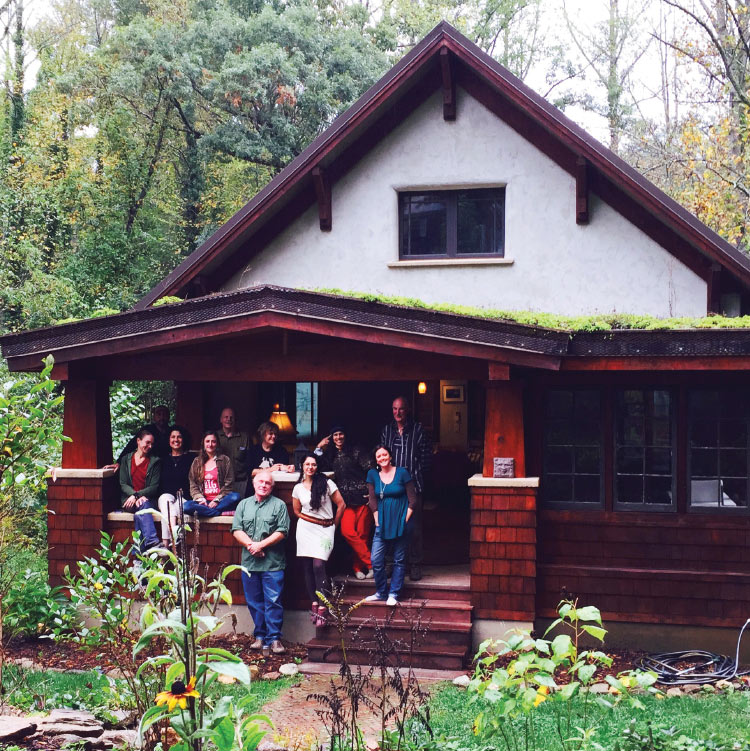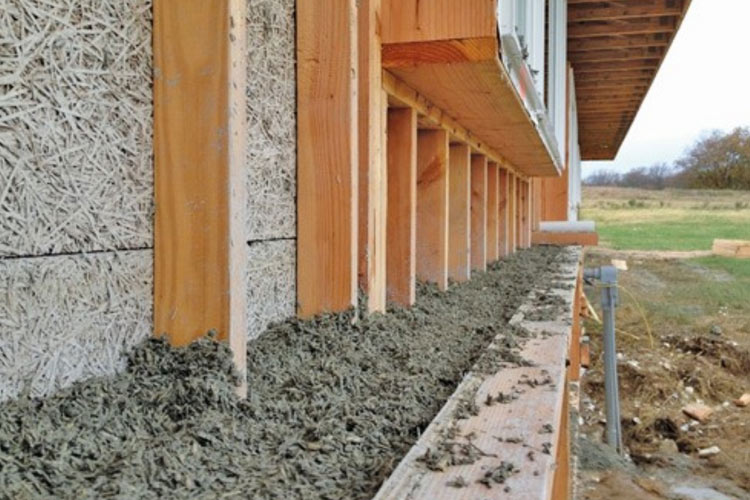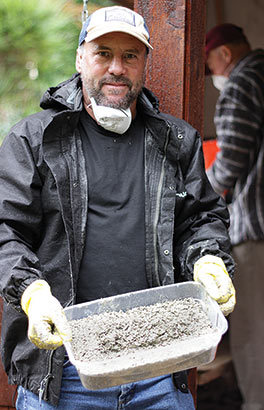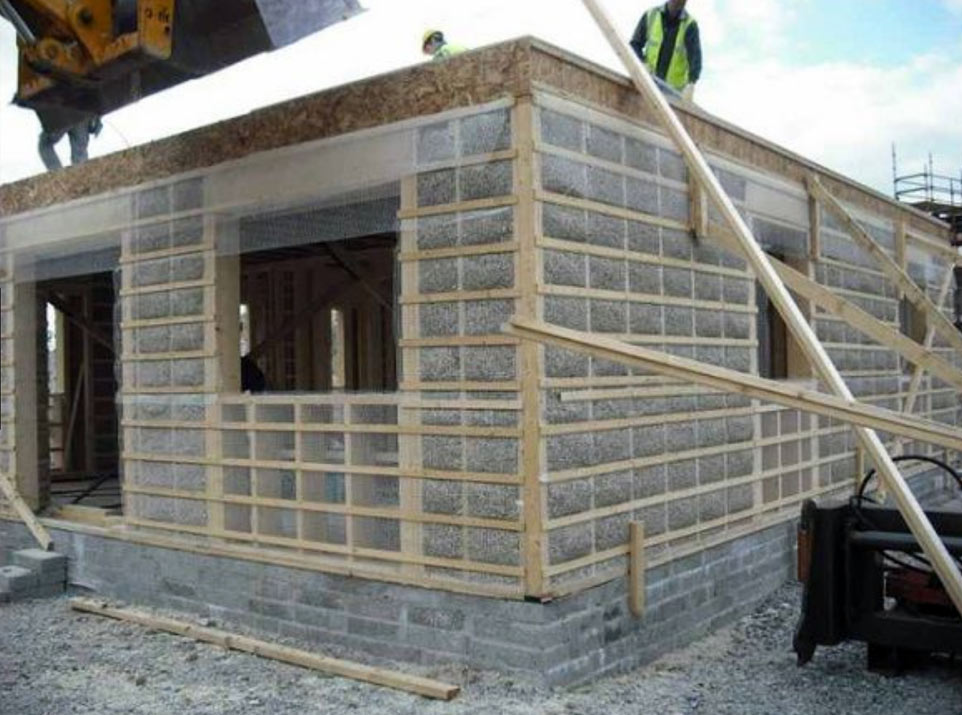During a rainy North Carolina weekend, people from Florida to Washington State gathered in the Smoky Mountains to learn about building with hemp. Skeptics as well as true-believers in all things hemp emerged from the weekend with a shared understanding: industrial hemp-based building materials can be used to build affordable – and in many ways, more desirable – residential and commercial structures.
By Jim Willmot

Workers at “The Nauhaus” in North Carolina.
If the many attendees at a recent hempcrete workshop held in Asheville, North Carolina were any indication of the growing interest in using hemp as a building material, then this movement is growing as fast as –well– a weed. The workshop was conducted by industrial hemp diehards Anndrea Hermann, dubbed “the First Lady of Industrial Hemp,” and Joy Beckerman Maher, an activist intimately involved in guiding state and federal policy-makers towards creating viable hemp programs.
Seventeen states currently allow industrial hemp farming for research and/or commercial purposes. However, the budding U.S. hemp industry is still presently lagging behind countries like Canada and China, who for years have been expanding their hemp productions.
For the environmentally-conscious builder, industrial hemp is a relatively untapped and limitless market. With an affordable housing crisis reaching near critical levels in many regions of the country, revival of the hemp industry could play an important role in lessening the mounting housing problem. Not to mention the viability of more than 25,000 hemp-based products on offer – from animal bedding to clothes to fuel to beauty products – and the jobs and wealth that this plant could create.
HEMPCRETE BUILDING BASICS
The fundamentals of building with hemp are centered around a simple “4:1:1 formula” – 4 parts industrial hemp, 1 part hydrated lime and 1 part water. Using the inner, woody core of the hemp plant (called hurd or shive) and carefully mixing it with hydrated lime and water, a most wonderful mixture called hempcrete is born.
After building wall forms or shutters around load-bearing timbers, one simply fills the forms with this bioaggregate, about a foot deep at a time. By lightly tamping the outside of the walls, the wall’s exterior gains rigidity and strength while the wall’s interior remains as the original light, moist, loamy mix. After a few days, the hempcrete sets and the shutters can be removed and rebuilt at a higher level. The process is repeated until the walls reach roof level. A finishing lime plaster is then applied to seal the walls, which protects the walls from heavy moisture and still allows the walls to breath. Completed hemp walls, once finished with clear plaster, have an attractive look similar to coral reef.
 A great example of what’s possible using hemp building materials is the Nauhaus built in Asheville – the first hempcrete structure in the U.S. to achieve LEED certification, a system that rates building sites on sustainability, indoor environmental quality and energy efficiency. Nauhaus’ lead designer Tim Callahan and his helpful team at Alembic Studios, who attended a portion of the hempcrete workshop, offered participants valuable tips for building with hemp.
A great example of what’s possible using hemp building materials is the Nauhaus built in Asheville – the first hempcrete structure in the U.S. to achieve LEED certification, a system that rates building sites on sustainability, indoor environmental quality and energy efficiency. Nauhaus’ lead designer Tim Callahan and his helpful team at Alembic Studios, who attended a portion of the hempcrete workshop, offered participants valuable tips for building with hemp.
Designers of Nauhaus say they’re working to help “revamp our modern built environment and create beautiful, healthy, livable spaces that grapple with climate change while improving the quality of your daily life.”
MEASURED GROWTH
Hempcrete, while a versatile and durable material, still has some obstacles to overcome. Because hempcrete building is in the infancy stage, experienced hemp-building contractors, architects and designers can be hard to find. The permitting process can also be painstaking, as many municipalities are unfamiliar with hemp construction, and since many hemp homes are one-off projects, the economies of scale that benefit traditional home building projects are still a ways in the future.
 As the nascent industrial hemp industry continues to grow in the U.S., industrial hemp prices will no doubt drop, as will the price of hemp construction. It will be interesting to see how this all plays out in the next decade or two. A few U.S. states – Kentucky and Oregon in particular – are clamoring to expand their hemp industries, despite past resistance from the DEA and other law enforcement agencies, who for years have stood in the way of production.
As the nascent industrial hemp industry continues to grow in the U.S., industrial hemp prices will no doubt drop, as will the price of hemp construction. It will be interesting to see how this all plays out in the next decade or two. A few U.S. states – Kentucky and Oregon in particular – are clamoring to expand their hemp industries, despite past resistance from the DEA and other law enforcement agencies, who for years have stood in the way of production.
Still, as more and more people engage with knowledgeable designers and contractors who incorporate the best in passive house design, people will discover that constructing these healthy, low-energy hemp living spaces is a viable alternative to traditional homes.
It would be great to see more hempcrete, and hemp products in general, used across the nation. Perhaps in the not too distant future, we might even see bales of hemp for sale at HomeDepot – or better yet, at your local farmer’s market.
The Wonders of Hempcrete
RESISTANT
Hempcrete is fire-resistant, termite-resistant, mold-resistant and rot-resistant. Its high vapor permeability allows walls to breath and acts to regulate indoor air humidity. As hempcrete ages, it goes through the petrification process as the organic matter of the hemp hurd slowly turns into stone.
LIGHTWEIGHT
Since hempcrete is much lighter than concrete, foundations need not be as deep. The pressure, or slump, on the lower part of wall forms or shutters is considerably less compared to building concrete walls.
 INSULATIVE
INSULATIVE
The incredibly high R-Value (insulative power) of hemp-built walls can lower energy costs significantly. A 12-inch wide hempcrete wall has an R value of 30 and a 16-inch wall has an R value of 40, while walls made using conventional home construction have R values in the 12 to 15 range.
VERSATILE
Hempcrete lends itself to great creativity versatility. Some hemp home builders employ glass bottles and/or other decorative materials within the walls for additional lighting and for artistic appeal. Roofs can also be made out of Hempcrete.
HEALTHFUL
The phrase “healthy house” is often used in connection with hemp buildings. Hemp is non-toxic and has “breathability” – a term used to describe the various ways in which building materials deal with wicking away moisture.
DURABLE
Through proper maintenance, hemp houses can last several centuries, as have many in Europe and elsewhere around the globe.

